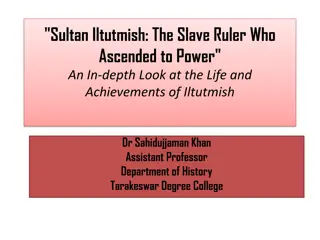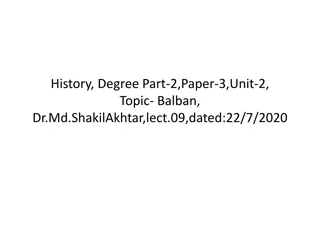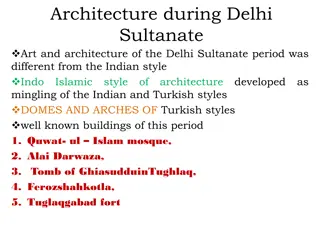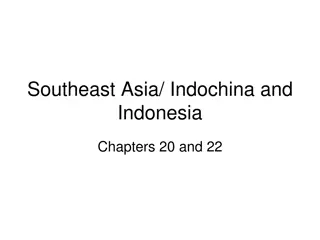The Sultanate Period in Delhi: A Historical Overview
Explore the rich history of the Sultanate Period in Delhi from 1206 to 1526, witnessing the rule of dynasties, notable rulers like Qutb-ud-din Aibak and Iltutmish, and the short but eventful reign of Raziya Sultan. Discover the intriguing dynamics of power, conflict, and succession in this era.
Download Presentation

Please find below an Image/Link to download the presentation.
The content on the website is provided AS IS for your information and personal use only. It may not be sold, licensed, or shared on other websites without obtaining consent from the author. Download presentation by click this link. If you encounter any issues during the download, it is possible that the publisher has removed the file from their server.
E N D
Presentation Transcript
SNS ACADEMY A fingerprint International School Affiliated to CBSE New Delhi Affiliation No :1930610 GRADE : 7 (2022-23) 1 COURSE NAME : SOCIAL SCIENCE Chapter-3 History THE SULTANATE PERIOD
THE SULTANATE PERIOD Period: From 1206 to 1526 Capital :Delhi Dynasties:5 Sources: Accounts of travellers and court chroniclers. Accounts of travellers:Ibn Batuta and Marco Polo Court chroniclers: Zia-ud-din Barani, Shams-i-Siraj Afif and Minhaj-us Siraj Other sources: Coins, Monuments and Inscriptions THE SULTANATE PERIOD
The ruler of this dynasty were called slaves or Mamulk Arabic meaning OWNED Iltutmish and Balban are the slaves of Qutb-ud-din Aibak. Qutb-ud-din Aibak also a slave of Muhammad Ghori. Qutb-ud-din Aibak Iltutmish Balban
Qutb-ud-din Aibak Founder of the dynasty Incharge of Muhammad Ghori s territories, what he was conquered in India. After Ghori s death he was an independent ruler He was a kind hearted person Lakh Baksh or giver of lakhs. Most of his wealth was given as charity
SHAMS-UD-DIN ILTUTMISH Qutb-ud-din Aibak was succeeded by Iltutmish. He was the real founder of the Sultanate. faced many problems but he faced it strongly. suppressed all the rebellions within the empire. protected north west frontier from the invasion of Mongols. Expanded his empire till Bengal. He had many sons but none capable for being a successor. So he made his daughter Raziya as Sultan. But his nobles were unhappy so after iltutmish s death they replaced her. His son Rukh-nud-din Firoz Shah ascended the throne. But he spent his time enjoying himself,paying little attention to Administering the sultanate So with peoples support Raziya Sultan became the ruler .
RAZIYA SULTAN 1236 TO 1240 Her ruling period was short and full of filled with problems. The nobles opposed her They hated taking order from a woman. They did not like Raziya for taking decision without consulting them. In 1240 they illegally removed her,soon after she died.
NASIR-UD-DIN MAHMUD After Raziya many kings came to the throne. Iltutmish s another son Nasir-ud-din Mahmud came to power, he was ruled from 1246 to 1266 . But he was a puppet of powerful nobles. After him Balban ascended the throne.
GHIYAS-UD-DIN BALBAN Most powerful ruler of the slave dynasty. He was one of an important noble since the reign of Iltutmish. Reorganised and strengthen the army. He defeated many local rulers. He also protected northwestern parts from the Mongols. He introduced persian customs like Sijdha ,(Sajdah(or Sijdah) and Paibos were a type of ritual ) Paibos or zaminbos: kissing the sultan s feet People against this. After Balban s successors were weak so Khalji nobles captured the throne.
Khilji sultans ruled nearly three decades. They expanded and consolidated the sultanate.
JALAL-UD-DIN FIROZ KHALJI He was the founder of Khalji Dynasty. But a weak ruler. He was followed peace and wanted to rule without violence. Adopted lenient policy towards Mongols and married Mongol leader Ulugh Khan s daughter. Jalaluddin was succeeded by his nephew Ali Gurshap , he took the title Ala-ud-din Khalji.
Ala-ud-din Khalji The most powerful leader of this dynasty. Soon after coming to power he set a goal to rule the whole India. Expansion of the empire Ala-ud-din conquered Gujarat and Malwa. He control over the sea ports. By 1301 and 1303 he campaigned in Rajasthan and captured Ranthambore port and Chittor from the Rajputs. He send a large army towards south under his trusted general Malik Kafur. Malik Kafur defeated Yadavas , Kakatiyas, Hoysalas and Pandyas. He brought huge war booty -precious metals, elephants, horses and slaves. defeated kings can continue as rulers but they have to pay tributes to Ala-ud-din. His empire was as large like Ashoka. Land revenue is important source of income He introduced many economic reforms
ECONOMIC MEASURES According to the fertility land was divided into different categories and he ordered all land to cultivate. Land tax (Kharaj) was fixed according to that. Raised land tax in the Doab region to one half of the produce. But he ensured peasants were not burdened. He kept strict check on the nobles and did not collect any additional taxes. He keep a check on his officers . Discourage corruption He introduced market control policy
REFORMS OF ARMY He used the revenue for maintaining large standing army. He paid low salary to his soldiers. Branding horse(dagh) ,branded the horses to prevent the substitution good horses by inferior one. Spies were appointed - to inform all the developments After his death war of succession broke out. Last khalji ruler was Khusrau Malik Ghiyas-ud-din defeated him and started the Tughluq dynasty
THE TUGHLUQ DYNASTY This dynasty ruled nearly 100 years Two powerful sultans _ Muhammad bin Tughluq and Firoz Shah Tughluq GHIYAS -UD-DIN TUGHLUQ(1320 - 1325) Founder of this dynasty He put down the rebellions and strengthened the Sultanate. He was succeeded by his son Jauna Khan with a title of Muhammad bin Tughluq.
Muhammad bin Tughluq Very powerful ruler. Ibn Batuta given a lot of information about his reign. His plans and ideas Taxation in the doab Shift of capital. Introduction of token corrency. Quarachil Expedition Khurasan Expedition
FIROZ SHAH TUGHLUQ (1351-1388) Cousin of Muhammad bin Tughluq. He wanted the support of nobles and ulema so he gave them iqtas it made hereditary. To please on ulema he followed Islamic laws. It resulted this two community grew very powerful.started influencing daytoday administration.
HIS REFORMS Built many canals,tanks,wells,hospitals and rest houses. He found a new town Jaunapur,Ferozpur,Firozabad and Hissar - Firoz He setup many educational institutions Many sanskrit works were translated to Persian and Arabic languages. After his death his empire broke up. Many regions became independent.
TIMURS INVASION(1398) The Mongoal ruler Timur invaded India. He was a central Asian ruler. attacked and he looted Delhi With the loot he beautified his capital Samarkhand with elegant buildings,palaces and mosques. Before leaving Delhi he appointed Khizr Khan as his deputy in India Khizr Khan became the first ruler of Sayyid dynasty
THE SAYYID DYNASTY The Khizr Khan Sayyid was the governor of Multhan , Lahore , and Dipalpur under Firoz Shah Tughluq After the death of Feroz he supported a son of Firoz, in the war of succession. Khizr Khan conquered Delhi in 1414 and started the rule of the sayyids. MUBARAK SHAH SAYYID 1421 - 1434 He succeeded his father, he revived the old glory of the Sultanate. Nobles are against him, most of his time used for controlling them.
MUHAMMAD SHAH SAYYID 1434 TO 1443 He was the nephew of Mubarak Shah. The nobles became very powerful in his period. ALA-UD-DIN ALAM SHAH SAYYID 1443 - 1451 He was the next ruler In 1451 he lost Delhi to Bahlul Lodhi. He was the last ruler of this dynasty.
THE LODI DYNASTY Until Lodis other all sultanate were Turkish origin. The Lodis were the Afghans. BAHLUL LODI He was the first ruler He tried to consolidated the fragmented Sultanate. Removed rebellious governors and appointed loyal Afghan nobles in their palace. At the time of his death , the sultanate stretched from Punjab and Bihar.
SIKANDAR LODI 1489 - 1517 Son of Bhalul Most powerful ruler He annexed Jaunpur and Bihar. Signed a treaty of friendship with the ruler of Bengal. Introduced many welfare measures. He tried to lower the prices of all essential commodities. Also gave loan to farmers. He found the city of Agra, made it his capital.
IBRAHIM LODI 1517-1526 He succeeded by Sikandar lodi, Afghan nobles rebelled against him,however he defeated them To prevent this revolts in future, he replaced senior nobles and governors, who had lot of power. The displaced nobles conspired with Babur,who overthrew Ibrahim Lodi in the first battle of panipat in 1526. Babur was the first ruler of the Mughal dynasty.






























